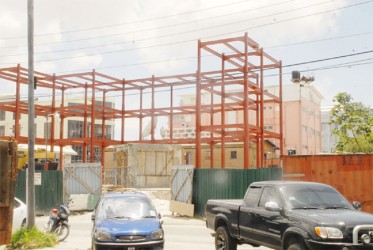There are quite a few significant construction projects unfolding in the city at this time and the general reaction to the building boom has been to equate it with what we loosely describe as development.
There is a line of reasoning which says that a city is not a city in the absence of malls and other multi-storey structures and sometimes we follow that line of reasoning without taking account of what is often its serious downside. Georgetown, for example, is a small city with a tradition of relatively small buildings and there are those who have argued that two large shopping malls within touching distance of each other have provided the Camp and Regent streets junction with a uncomfortably, claustrophobic feel.
It is, however, the building boom that is the essence of this article and one’s first reaction to it has to do with its job-creation effect. While we have not, for years, been privy to the country’s unemployment figures it is reassuring to see scores of men reporting for work on construction sites and to know that after these structures

have been erected there will be more work yet for other people in the various other sectors of the country’s economy.
None of this, however, can gainsay the considerations of safety and health that are associated with what would appear to be the erection of taller structures, sometimes in spaces that appear to be much too small to accommodate them. One of the space-related concerns that is clearly not receiving sufficient attention has to do with the simultaneous nature of the building boom and the seemingly ceaseless importation of motor vehicles into the country. Between large buildings and a host of vehicles there is simply not enough space for both and gradually, we appear to be arriving at a point where the ridiculous situation that applies in the region of the Guyana Revenue Authority complex on Camp Street will be replicated elsewhere.
There is a host of other issues associated with this shift in the building culture. There is need, for example, for a strong culture of safety and health rules and, more importantly, enforcement procedures that give teeth to those rules.
There is a pretty widespread view that we in Guyana have grown accustomed to cutting corners in the building sector. A great many people also believe that the process associated with the granting of building permits is dripping with corrupt practices. What is worrying too is that the Occupational Safety and Health Department of the Ministry of Labour does not appear to be on the ball as far as running a tight safety and health ship is concerned.
It is not so much that one disagrees with the recent modest attempts at public education on safety and health in the construction sector which this newspaper has undertaken. What we really need, perhaps above all else, is credible evidence that we are prepared to enforce the law. There is no such evidence at this time. What we lack is a system that combines an aggressive programme of public education on safety and health in the construction sector with efficient executing agencies that are prepared to read the riot act whenever a blatant transgression occurs.
There is a reason why we must adopt this approach. Increasingly, in areas of safety and health, as in various other areas of national life, there is evidence that transgression of the law occurs largely on account of a lack of mindfulness of the resolve and effectiveness of the executing agency. This has to do sometimes, with the view that those agencies lack the enforcement capacity, or else, that they can be corrupted. Accordingly, laws have become weak and ineffective purely for the reason that we have allowed them to be broken far too many times without doing anything about the transgressions. It is not so much a matter of reminding people–building contractors, construction site supervisors etc–that safety and health laws exist, but ensuring that those laws are effectively enforced. In other words, the reminder should repose in the effective application of the penalty for transgression. Rules and regulations become ineffective when we create too many exceptions and exemptions to them and when people are not made to be sufficiently mindful of the penalties for transgression.
The great fear in the construction sector is that we may be becoming increasingly indifferent to considerations of safety and health in circumstances where business considerations like cutting corners become more important than the safety of workers. Whether we like hearing about it or not, the fact of the matter is that we do not, these days, place overwhelming emphasis on safety and health as it relates to the ordinary worker on the huge construction site. So that accidents of that nature tend to come and go quickly after they have lost their newsworthiness. The other issue, of course, has to do with an increasing sense that we live in a ‘money talks’ kind of society and that issues like safety and health in the construction sector have long been subsumed beneath that culture.








